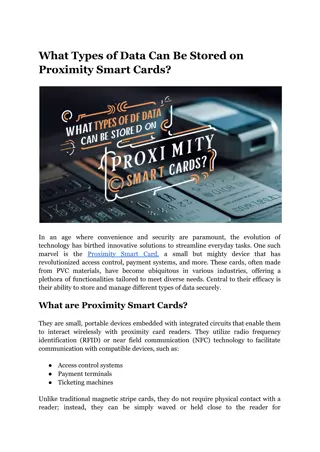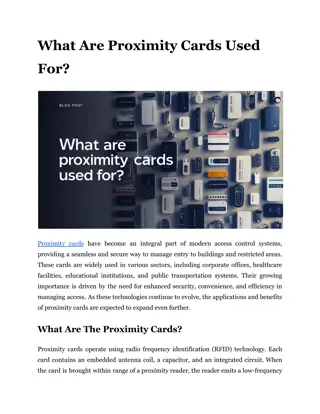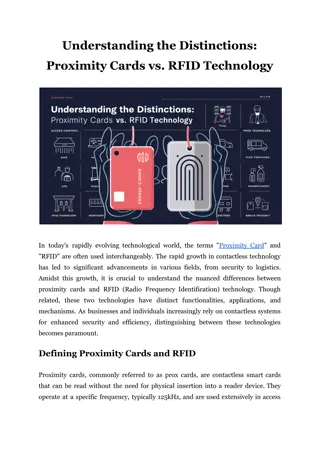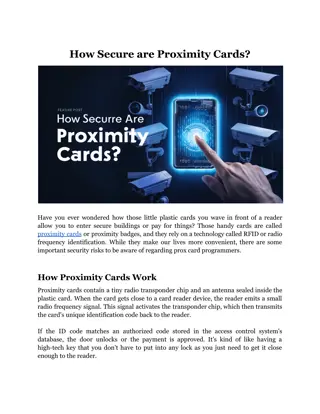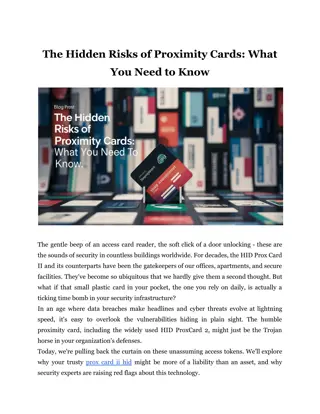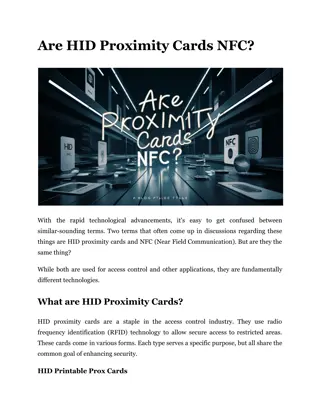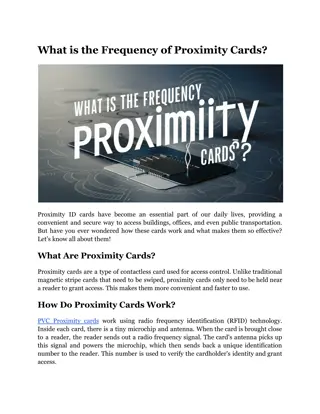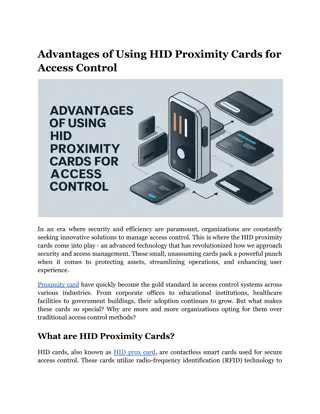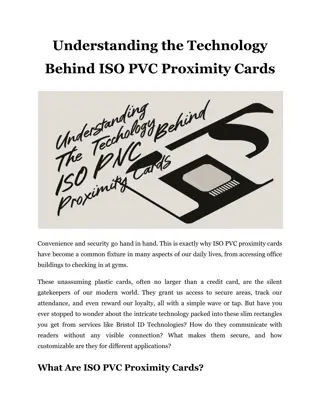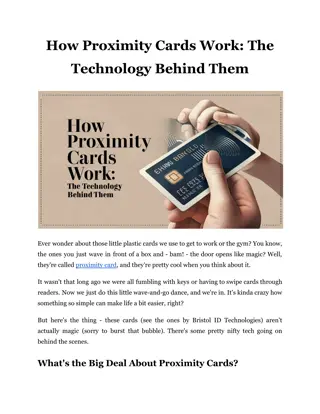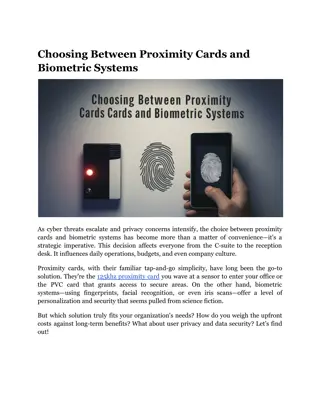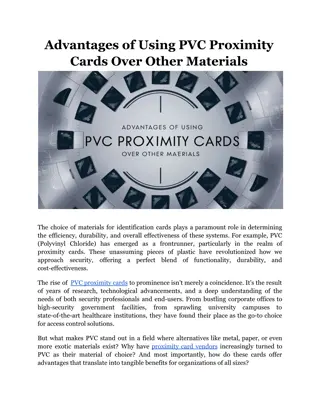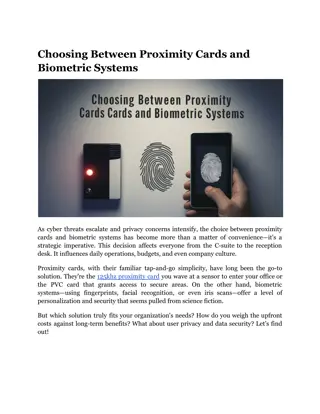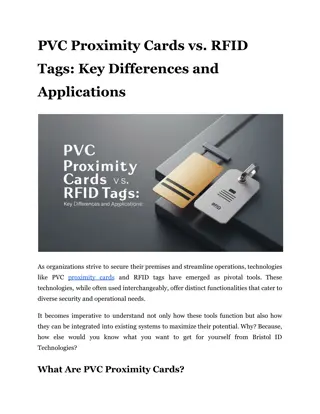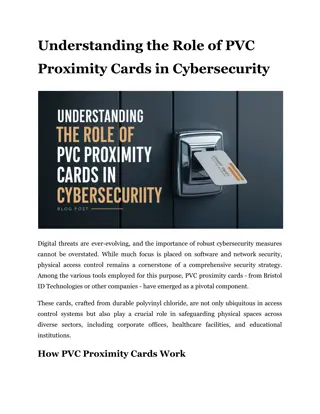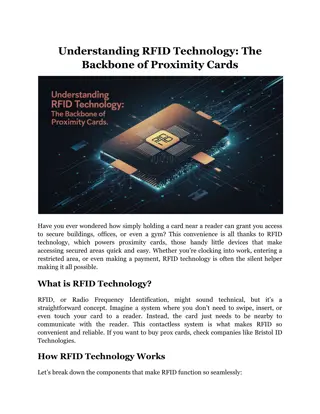
Who Uses Proximity Cards?
Unsure who uses proximity cards? Used for access control & beyond, explore the wide range of industries that rely on these contactless cards for security and convenience
Download Presentation

Please find below an Image/Link to download the presentation.
The content on the website is provided AS IS for your information and personal use only. It may not be sold, licensed, or shared on other websites without obtaining consent from the author. If you encounter any issues during the download, it is possible that the publisher has removed the file from their server.
You are allowed to download the files provided on this website for personal or commercial use, subject to the condition that they are used lawfully. All files are the property of their respective owners.
The content on the website is provided AS IS for your information and personal use only. It may not be sold, licensed, or shared on other websites without obtaining consent from the author.
E N D
Presentation Transcript
Who Uses Proximity Cards? Proximity cards, also known as prox cards, are a staple in modern access control systems. They operate using radio frequency identification (RFID) technology and allow users to gain entry to secure areas without the need for physical contact. These cards are prevalent in various sectors due to their convenience, security features, and versatility. The technology behind proximity cards is both simple and ingenious. When a proxy card comes within range of a compatible reader, the RFID chip embedded in the card communicates with the reader via radio waves. This interaction transmits a unique identification number, which the access control system then uses to grant or deny access. The convenience of this system is undeniable as users can gain entry without the need to swipe or insert a card, which speeds up the overall access process.
Who Uses Proximity Cards? 1. Corporate Sector In the corporate world, security and efficient access control are paramount. 26 Bit Proximity Cards are commonly used in offices and corporate buildings to manage employee access. They ensure that only authorized personnel can enter certain areas, such as executive offices, server rooms, and confidential document storage. By using these cards, companies can track employee movements, monitor attendance, and enhance overall security. Large corporations often use ISO Proximity PVC Cards because of their compatibility with a wide range of access control systems. They are not only durable but also offer a standardized format that simplifies integration with existing security infrastructure. Moreover, proximity cards reduce the risk of unauthorized access, as they are difficult to duplicate compared to traditional keys. Read More Articles: Four Popular Home Styles in Murray Hill, Manhattan 2. Educational Institutions Schools, colleges, and universities are increasingly adopting proximity cards to secure their campuses. PVC Proximity Cards are widely used to manage student and staff access to classrooms, libraries, dormitories, and administrative offices. They enhance campus security by determining that only registered individuals can enter specific buildings or areas. In addition to access control, educational institutions use proximity cards for various other purposes, such as meal plans, library checkouts, and event attendance tracking. The versatility of proximity cards makes them an ideal solution for managing multiple functions with a single card. 3. Healthcare Facilities Hospitals and healthcare facilities require stringent security measures to protect patients, staff, and sensitive information. ISO PVC Proximity Card systems are
extensively used in these environments to control access to patient wards, medication storage rooms, and administrative offices. Healthcare facilities also benefit from the hygienic nature of proximity cards. Since these cards do not require physical contact with readers, they help reduce the spread of germs and contaminants - a crucial consideration in medical environments. 4. Government and Military Government buildings and military installations demand the highest levels of security. Proximity cards are an integral part of their access control systems due to their high-security features, providing secure and efficient entry for authorized personnel. Apart from controlling access to secure areas, proximity cards are used to manage sensitive data and equipment. For instance, access to classified documents, computer systems, and secure communication devices is often restricted through the use of proximity cards. This makes sure that only personnel with the appropriate clearance levels can access critical information. 5. Hospitality Industry Hotels and resorts use proximity cards to enhance guest convenience and security. 26 Bit Proximity Cards are commonly issued to guests upon check-in, which enables them to access their rooms and other hotel facilities, such as gyms, pools, and lounges. They are also used for in-room safes to ensure that guests can securely store their valuables. Proximity cards improve the guest experience by eliminating the need for traditional keys, which can be easily lost or forgotten. 6. Residential Complexes In residential settings, proximity cards provide a convenient and secure way for residents to access their homes and shared facilities. PVC Proximity Cards are often used in gated communities, apartment buildings, and condominiums to control entry to the main gates, parking garages, and recreational areas. They offer residents a high level of security while simplifying access. For instance, residents can easily enter their building without fumbling for keys, and property managers can quickly deactivate lost or stolen cards.
7. Transportation and Transit Systems Public transportation systems and transit authorities use proximity cards to manage access to trains, buses, and other transit services. ISO PVC Proximity Card systems streamline fare collection and improve the efficiency of transit operations. Riders can simply tap their proximity card on a reader to pay for their journey, reducing the need for cash transactions and speeding up boarding times. Furthermore, proximity cards also provide valuable data for transit authorities, helping them analyze usage patterns and optimize service delivery. Additionally, they boost security since only paying customers can access transit services. Read More Articles: Honeyed Happiness: Why Coffee and Honey Make the Ultimate Duo? 8. Event Management Large events, such as concerts, conferences, and sporting events, often utilize proximity cards for access control and attendee management. They are issued to attendees to permit them to enter the event venue and access specific areas, such as VIP sections or backstage areas. In addition, they help event organizers manage crowd control and uplift security by preventing unauthorized access. They also facilitate smooth entry and exit for attendees, which improves the overall event experience. Conclusion Proximity cards have become an essential tool for access control across various industries. From corporate offices and educational institutions to healthcare facilities and government buildings, these cards provide a secure, convenient, and versatile solution for managing access. As technology continues to evolve, they are likely to play an even more significant role in safeguarding and streamlining access in diverse settings. From 26 Bit Proximity Cards to high-end ISO Proximity PVC Cards, our team at Bristol ID Technologies offers a range of technology-based products to boost the safety of your assets!




